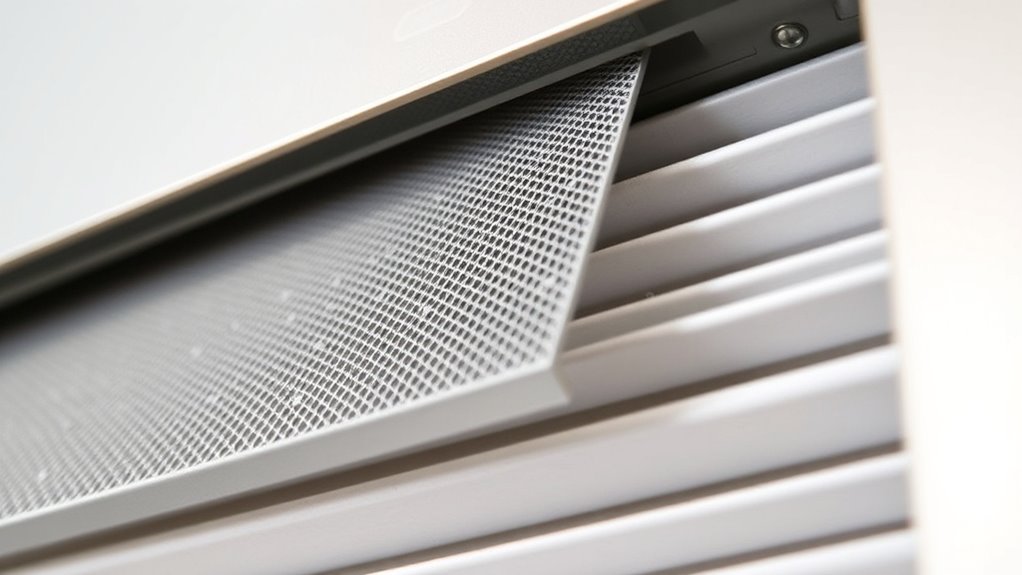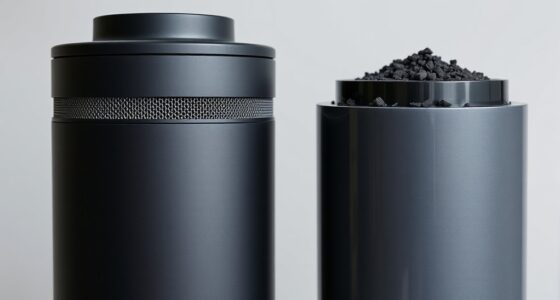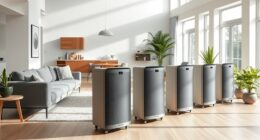Pre-filters capture larger particles like dust, pet dander, and hair before they reach your HEPA filter. By doing so, they reduce clogging and airflow resistance, which helps extend the filter’s lifespan. Using quality materials and maintaining them regularly guarantees continuous protection and efficiency. Proper pre-filter use keeps your system running smoothly and reduces costs over time. To learn how to choose and maintain your pre-filters effectively, keep exploring these essential steps.
Key Takeaways
- Pre-filters capture large particles, reducing clogging and pressure drop on HEPA filters.
- Regularly maintained pre-filters prevent debris buildup, extending HEPA filter lifespan.
- Choosing durable pre-filter materials minimizes replacement frequency and system downtime.
- Proper pre-filter selection maintains optimal airflow, reducing strain on HEPA filters.
- Well-maintained pre-filters lower energy consumption and enhance overall filtration system efficiency.
How Pre-Filters Capture Larger Particles

Pre-filters play a crucial role in keeping your air purifier functioning efficiently by trapping larger particles before they reach the main HEPA filter. They are designed to target particles based on size, effectively capturing dust, pet dander, and hair that are too big to pass through. When larger particles are removed early, the airflow resistance within the system decreases, allowing your purifier to operate smoothly and use less energy. By filtering out these bigger particles, pre-filters help prevent clogging and extend the life of your HEPA filter. This process ensures cleaner air and maintains ideal airflow, making your air purifier more effective over time. Keeping your pre-filter clean also ensures it continues to trap large particles efficiently, supporting the system’s overall health. Additionally, using high-quality pre-filters can further enhance the filter lifespan and overall efficiency of your air purification system.
Benefits of Using Pre-Filters in Air Filtration Systems
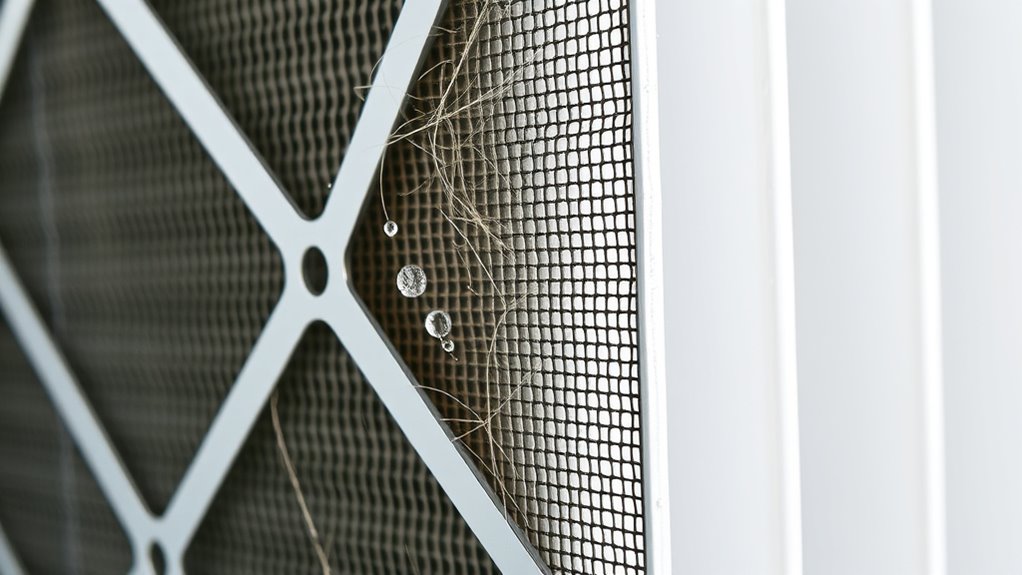
Using pre-filters offers several key advantages that enhance the overall performance of your air purification system. First, they improve airflow optimization by preventing larger particles from clogging the main HEPA filter, ensuring consistent airflow and system efficiency. This means your system works more effectively and requires less energy. Additionally, pre-filters contribute to cost reduction by extending the lifespan of your HEPA filters, reducing the frequency of replacements and maintenance expenses. They also help maintain better indoor air quality by capturing debris early, which minimizes strain on your entire filtration setup. Furthermore, pre-filters can help reduce the buildup of pollutants that may cause malfunctions or reduce the lifespan of the device filter maintenance. Overall, incorporating pre-filters boosts system durability, saves you money, and ensures cleaner air, making them a smart investment in your air filtration strategy.
Materials and Types of Pre-Filters
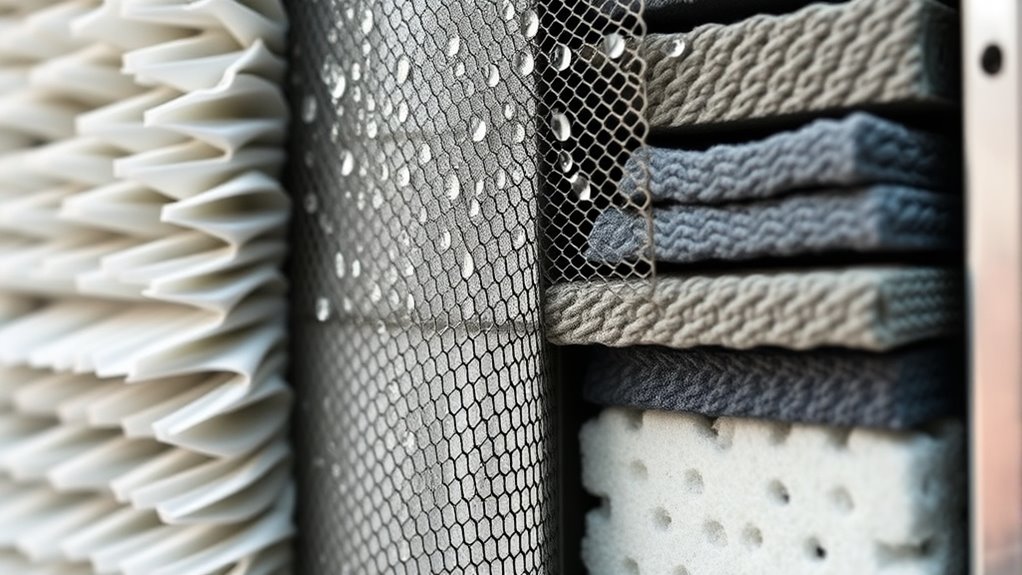
Pre-filters come in various materials, each offering different benefits and durability. You can choose from options like fiberglass, polyester, or electrostatically charged fibers, depending on your needs. Understanding their durability and maintenance requirements helps you select the right type for your air filtration system. Additionally, filter replacement indicators can help monitor when pre-filters need to be cleaned or replaced to maintain optimal performance.
Common Pre-Filter Materials
To effectively remove larger particles and extend the life of your main filtration system, selecting the right pre-filter material is essential. Common pre-filter materials include fiberglass, polyester, and non-woven fabrics, which trap dust, hair, and larger debris efficiently. Activated carbon pre-filters are also popular for adsorbing odors, gases, and chemical vapors, providing an extra layer of purification. HEPA pre-filters are designed to capture particles before they reach the main HEPA filter, reducing clogging and maintaining airflow. The choice of material depends on your specific needs, such as whether you’re targeting airborne particles, odors, or gases. Using appropriate pre-filter materials not only prolongs your HEPA filter’s lifespan but also improves overall air quality. Understanding the importance of filter maintenance helps ensure optimal performance and durability of your filtration system.
Types of Pre-Filters Available
There are several types of pre-filters available, each designed to address specific air purification needs. The most common include fiberglass, foam, and washable fabric filters. Fiberglass pre-filters are affordable and excellent for capturing larger particles, but they can impact your air purifier aesthetics if not replaced regularly. Foam filters are durable and washable, making pre filter installation easy and cost-effective over time. Washable fabric filters offer versatility and can be customized to fit your unit, enhancing the overall look. When choosing a pre-filter type, consider how it will fit into your air purifier’s design and the ease of pre filter installation. Selecting the right pre-filter ensures ideal airflow, better filtration, and longer HEPA filter lifespan. Additionally, understanding regional air quality variations can help you select the most effective pre-filter for your environment.
Material Durability & Maintenance
Choosing the right pre-filter involves considering its material durability and how easy it is to maintain over time. Durable materials like electrostatically charged media or synthetic fibers resist chemical exposure, guaranteeing they won’t degrade quickly. Chemical resistance is essential if your environment contains cleaning agents, solvents, or other corrosive substances. Moisture resistance is equally important, especially in humid settings where mold and bacteria can develop. Filters made from moisture-resistant materials stay effective longer and require less frequent replacement. Regular maintenance, such as inspecting for damage and cleaning or replacing filters as needed, helps maximize their lifespan. Additionally, selecting pre-filters with long-lasting materials can reduce the frequency of replacements and maintenance efforts. By selecting pre-filters designed for your specific environment, you guarantee performance and extend the life of your HEPA filters.
Selecting the Right Pre-Filter for Your System
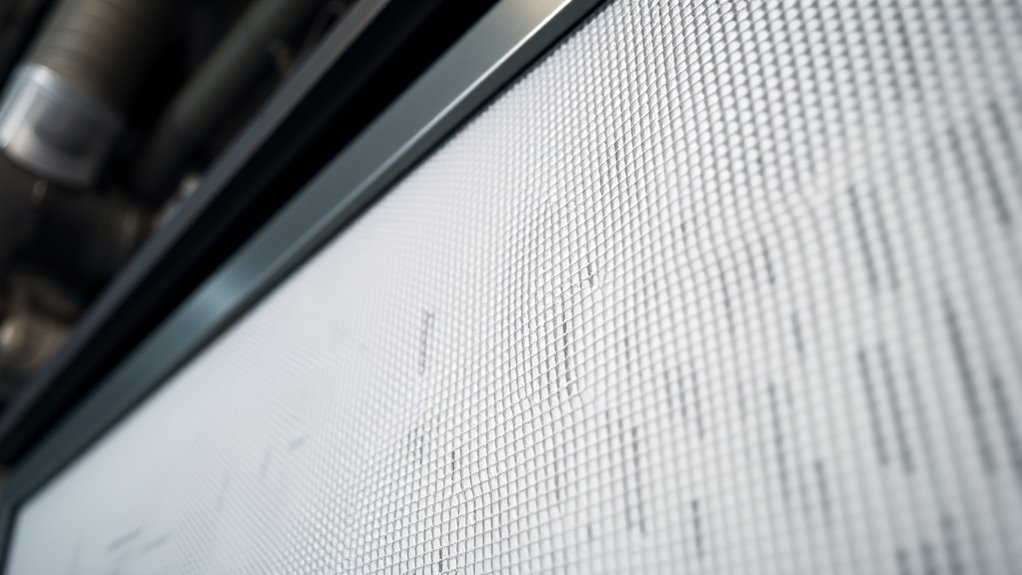
Choosing the right pre-filter depends on your system’s air quality needs and the compatibility of filter materials. You need to match the filter’s material with your environment to make certain of effective cleaning without damaging your system. Let’s explore how to select a pre-filter that balances performance and durability. Incorporating vertical storage solutions can also help organize replacement filters and maintenance tools for your system.
Filter Material Compatibility
Selecting the right pre-filter material is essential to guarantee compatibility with your HVAC or air purification system. You need to consider filter material compatibility to ensure the pre-filter functions effectively without damaging your equipment. Different environments and applications demand materials with specific chemical resistance, especially if your system handles fumes, vapors, or corrosive substances. Using incompatible materials can lead to degradation, reduced airflow, or contamination of the air. Choose pre-filters made from materials that resist chemicals common in your setting. This not only extends the filter’s lifespan but also protects the main HEPA filter from premature fouling. Always verify the chemical resistance of your chosen material and confirm it matches your system’s specific needs for maximum performance and longevity. Additionally, understanding the importance of attention in creative practice can help in selecting materials that are both durable and adaptable to changing environmental conditions, ensuring sustained filter performance over time.
System Air Quality Needs
Understanding your system’s air quality needs helps you pick the right pre-filter to maintain ideal performance. Assess the level of airborne particles your environment generates to determine the filter’s efficiency requirements. For low contamination, basic pre-filters may suffice, but higher dust or pollutant levels demand more robust options. Properly selected pre-filters support airflow optimization, preventing pressure drops that could strain your system. Balancing cost considerations is essential; while higher-grade filters last longer and provide better protection, they may incur higher upfront expenses. Evaluating your system’s specific air quality needs ensures you choose a pre-filter that effectively captures contaminants without compromising airflow or inflating costs. This targeted approach prolongs HEPA filter life and maintains optimal system performance.
Maintenance and Replacement of Pre-Filters
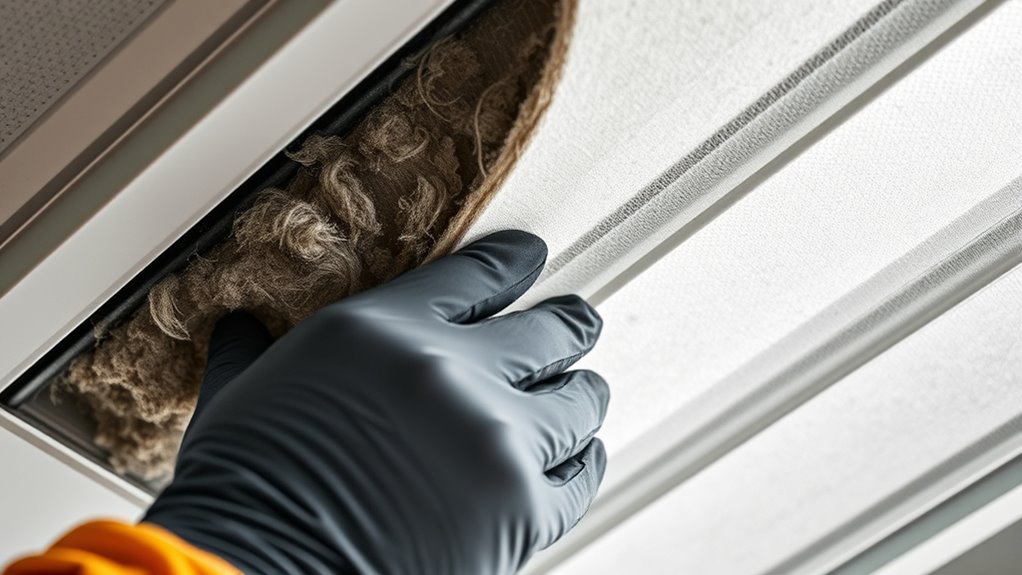
Regular maintenance of pre-filters is essential to guarantee your air purifier functions effectively. When you replace or clean pre-filters timely, you optimize airflow, which helps the system operate efficiently and extend HEPA filter life. Proper maintenance also prevents clogging, reducing strain on the system and lowering energy costs. To keep your system in top shape, consider these steps: 1. Inspect filters regularly for dirt and debris. 2. Clean or replace pre-filters as recommended by the manufacturer. 3. Avoid neglecting filter replacement to prevent airflow restrictions. 4. Maintain a consistent schedule to maximize filter lifespan and reduce costs. Regular filter upkeep can be supported by understanding the importance of air quality management in prolonging filter performance.
Impact of Pre-Filters on Overall System Efficiency
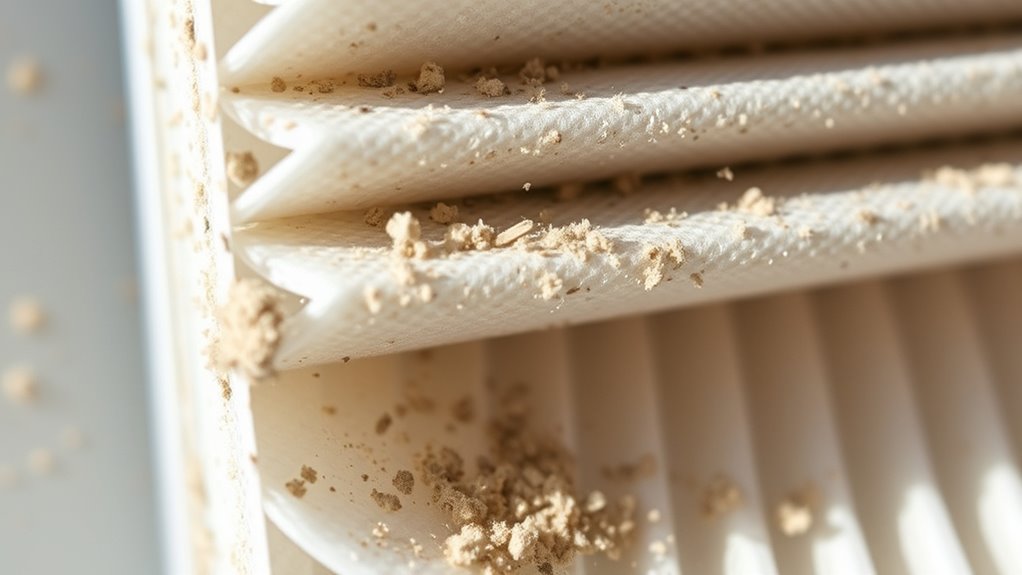
Pre-filters play a crucial role in maintaining your air purifier’s overall system efficiency. They influence airflow dynamics by capturing larger particles before they reach the HEPA filter, reducing strain on the system. A well-designed pre filter enhances airflow, preventing pressure drops that can decrease performance. The effectiveness of the pre filter design directly impacts how smoothly air moves through the unit, ensuring consistent filtration without overworking the fan. When pre-filters are properly maintained and maximized, they help extend the lifespan of your HEPA filter and improve energy efficiency. Conversely, poorly designed or clogged pre-filters restrict airflow, increase energy consumption, and reduce overall system efficiency. Thus, selecting the right pre filter design and keeping it clean are essential for ideal air purifier operation. Additionally, understanding AI Discoveries can lead to innovative solutions for optimizing filter performance and system longevity.
Frequently Asked Questions
How Do Pre-Filters Affect Energy Consumption in Air Filtration Systems?
Pre-filters improve your air filtration system’s energy savings by capturing larger particles before they reach the main HEPA filter. This reduces the workload on the HEPA filter, making it more efficient and lowering energy consumption. As a result, your system runs more smoothly, uses less power, and maintains better filter efficiency over time. Including pre-filters helps you save energy while extending the lifespan of your primary filtration components.
Can Pre-Filters Eliminate Odors or Chemical Pollutants?
Imagine walking into a room filled with a faint, unpleasant odor or chemical fumes. Pre-filters mainly trap larger particles, so they don’t eliminate odors or chemical pollutants. For odor removal and chemical filtration, you need specialized filters like activated carbon or charcoal, which absorb volatile compounds. Pre-filters alone can’t do the job, but they protect these advanced filters, helping them last longer and work more effectively.
Are There Environmentally Friendly Options for Pre-Filters?
You’re wondering if eco-friendly options for pre-filters exist. Yes, they do! You can choose pre-filters made from biodegradable materials that break down naturally, reducing waste. Additionally, look for filters coated with eco-friendly substances that don’t harm the environment. These choices help you maintain air quality while supporting sustainability efforts, making your air purification system more environmentally responsible without sacrificing performance.
How Do Pre-Filters Perform in High-Humidity Environments?
You might notice that high humidity impacts pre-filters by causing moisture buildup, which can lead to filter degradation over time. Excess humidity can encourage mold and bacteria growth, reducing filter efficiency and lifespan. To prevent this, you should consider using pre-filters made from moisture-resistant materials or installing dehumidifiers in humid environments. Regularly inspecting and replacing pre-filters helps maintain peak performance despite humidity challenges.
What Are Signs Indicating Pre-Filter Replacement Is Necessary?
Think of your pre-filter as the gatekeeper of your air purifier. When it gets clogged with dust, dirt, or debris, it struggles to breathe, signaling it’s time for a change. Look out for visible dirt, reduced airflow, or increased energy use—these are signs your filter lifespan is nearing its end. Stick to a maintenance schedule, and replacing the pre-filter at the right time keeps your system running smoothly and efficiently.
Conclusion
By adding a pre-filter, you’re giving your HEPA system a head start, much like a shield protecting a knight. It captures larger particles before they reach the main filter, extending its life and boosting efficiency. Regular maintenance keeps this shield strong, ensuring your air stays clean and healthy. Think of pre-filters as the first line of defense—your secret weapon for fresher, clearer air and a longer-lasting filtration system.
